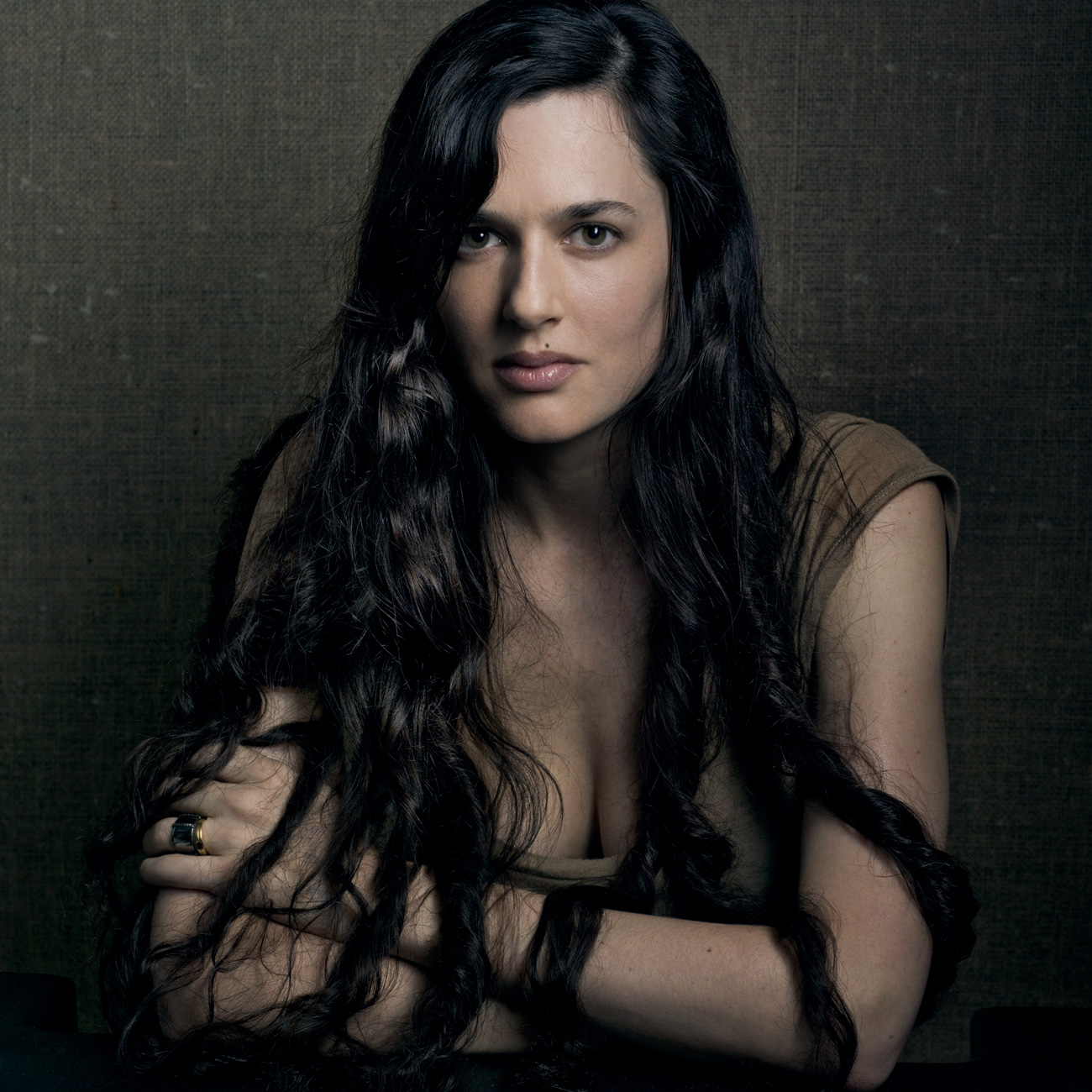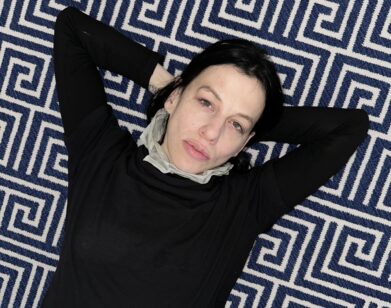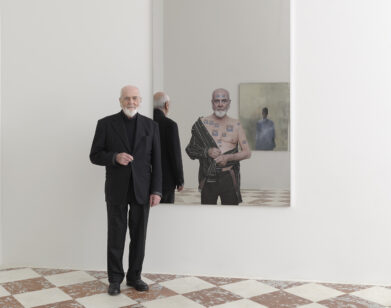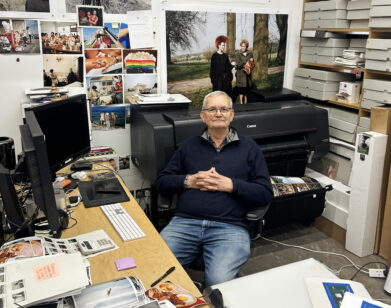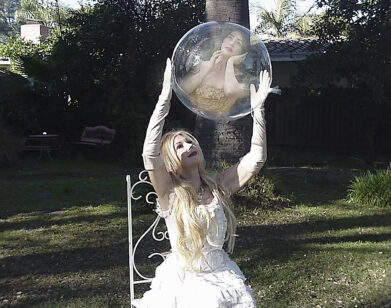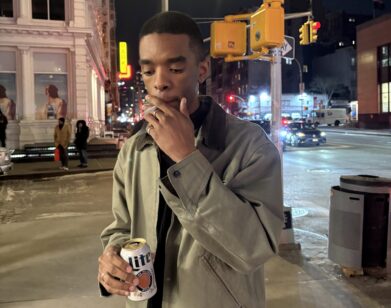Taryn Simon
In a period where artistic process and product have largely merged, Contraband, the latest series by photographer Taryn Simon, could arguably be an example of the most radical disparity between an end result and the grueling, frantic hours it took to get there. For five days last November, the 35-year-old Simon and her small team of assistants set up a makeshift studio at New York’s John F. Kennedy International Airport in the U.S. Customs and Border Protection Federal Inspection Site and the U.S. Postal Service International Mail Facility. In other words, Simon got a direct, uncensored look at all of the confiscated items coming through one of the country’s most active entryways-arriving via passengers, mail, and cargo. Around the clock, from November 16 to 20, with only the occasional comfort of an air mattress in lulls, Simon fought sleep deprivation to shoot more than a thousand items that were seized by the CBP Officers and Agricultural Specialists. Presented in a stark forensic style and organized alphabetically by genus, Contraband reveals such diverse confiscations as fake gold jewelry, guinea pig meat, fashion accessories, video games, spices, fruits, herbs, the date-rape drug GBL, steroids, endangered species, erectile-dysfunction medication, starter guns, sugar cane, counterfeit golf equipment, DVDs, and hair irons and basically every other fake or illegal item or substance that leaks into a controlled democracy on a daily basis. Contraband isn’t the first time Simon has undergone physical extremes for her work-in her 2003 series The Innocents, she trekked all over the country to take portraits of wrongly convicted prisoners, and in her 2009 series An American Index of the Hidden and Unfamiliar, she managed to gain access to some of the most precarious and guarded locations on earth-including her first foray into Customs at JFK.
Simon is a rare artist who manages to be a hybrid between documentarian and formal technician. She opens the world up at the same time she freezes it in frame. While preparing for simultaneous shows for Contraband at New York’s Lever House (September 30-December 31) and Gagosian Gallery in Beverly Hills (September 22-November 6), she talked by phone to Fred Skolnick, Deputy Chief Agricultural Specialist in the passenger-baggage section at JFK, who helped her during those five days of sifting through the seizures.
FRED SKOLNICK: How is the crew doing?
TARYN SIMON: Well, everybody finally got some sleep. [laughs]
SKOLNICK: One of the reasons I was happy to help you out is because you are so dedicated. I was impressed. Anyone who can go without sleep for five days is my kind of person. I’m not an artist. I’m actually a musician-or a would-be musician.
SIMON: What kind of music do you play?
SKOLNICK: I’ve gone through the gamut of bluegrass, old swing, country western, and jazz. You know, it’s very typical for Orthodox Jews to play bluegrass and jazz.
SIMON: Why are Orthodox Jews playing bluegrass
SKOLNICK: Andy Statman, one of the greatest bluegrass mandolinists in the world, is an Orthodox Jew. He’s a demigod of the bluegrass world. There are a lot of Jews in bluegrass.
SIMON: Do you still perform?
SKOLNICK: I don’t. I basically just play at home now. But since my mom just passed away, I have to take a 12-month hiatus from music, which will drive me crazy.
SIMON: That’s right. You’re not allowed to have any music.
SKOLNICK: No, it’s not allowed. If you follow the dictum of the rabbis, you should refrain from partying for 12 months. Music is soothing for the soul, and for mourning you’re supposed to feel some pain. But let’s back away from theology and get back to art. I know this wasn’t the first time that you’ve photographed at JFK. What was it about your experience there that made you want to come back and work with us again?
SIMON: The first time I was there was just for one photograph, so it was a comparatively brief appointment with the Customs crew-and that was all I could get at the time. For that shoot, they had collected all of the food and agricultural seizures for the past 24 hours on a table for me. I arranged and photographed the contraband. Spending time with the agents and seeing what goes on there, I got the sense that I had only gotten a brief glimpse at what you guys are really collecting.
SKOLNICK: What we do intrigued you to come back?
SKOLNICK: How do you gain access to so many restricted areas? What is the process you use?
SIMON: There’s no formula. It’s usually a series of letters and phone calls. It depends on who’s on the receiving end. Sometimes, although rarely, we actually get somebody who’s interested in art and eager to participate in a creative project. With others, it requires a more political approach. In the case of JFK, John Saleh [CBP Officer and Public Affair’s Liaison] was my hero. He understood the proposal’s potential and worked so hard to develop it into what it became.
SKOLNICK: You pretty much stayed in the airport for a week-between the mail branch, cargo, and passenger baggage. How did you prepare for this? What were the logistics involved?
SIMON: Our preparation for the project was strictly technical. We had all the specs of the room mapped out in advance and ran several tests to identify the best lighting scenario and backdrop color for our ministudio that we set up in your domain.
Blue and yellow pharmaceutical pills awaiting testing, Pakistan (prohibited), 2010
SKOLNICK: I was impressed by the amount of technical equipment you brought in. It reminded me of being a musician.
SIMON: It’s burdensome-lots of heavy bags.
SKOLNICK: But you’ve got to suffer for art, right?
SIMON: I guess so. I always do. We set everything up the night before our official shooting began. It took a while to get things perfect. Our only additional piece of gear was an air mattress that the team used on rotation between flights and the hours of heavy influx of goods. But none of us were actually prepared for the level of sleep deprivation we ended up experiencing, that’s for sure.
SKOLNICK: You were walking around like zombies toward the end, and I felt so bad for you I wanted to cry. I can go without food, but not sleep.
SIMON: I remember that last day, I was sitting with the trigger in my hand at the camera and my assistant literally had to hit me to wake me up so I could press the button. And it was especially surreal having all of those strong smells and confiscated objects surrounding us in a sleep-deprived state.
SKOLNICK: I’m curious how your interactions were with the agricultural specialists and the CBP officers. How did you feel about working alongside us? You actually saw some inspections of baggage going on.
SIMON: I was amazed by the particulars of the process-the knowledge base required to identify seizures: its species name, its history, if it has wood-boring insects . . .
SKOLNICK: It’s part of our job every day, and you just get to know the items. We see a lot of weird stuff pass through the department. What items intrigued you most?
SIMON: Well, I didn’t get my pig’s head, like last time. But one of the big moments was in the mail branch. They brought in this big envelope from the wildlife division. The envelope was open and they gave us gloves and masks. We reached our hands in and out came this enormous bird and a bunch of animal parts.
SKOLNICK: A dead bird? It was for taxidermy purposes probably, right?
SIMON: The customs worker speculated that it was for witchcraft.
SKOLNICK: Oh, yeah. We get that from Africa sometimes. We get mud nests and dead birds for voodoo rituals, so that makes perfect sense.
SIMON: Do you know how they are used?
SKOLNICK: No. I haven’t practiced voodoo in a couple of years, so I forget. [laughs] What was some of the stuff in baggage that interested you? I remember you were drawn to some of the things coming in from China.
SIMON: For baggage, I was taken by the sheer simplicity of some of the items, like sausages and fruit, which seem so innocuous, but under customs scrutiny become serious security or economic threats.
SKOLNICK: We just got a bunch of mangos from Bangladesh the other day, and they were so badly infested with seed weevils that we didn’t even have to cut them open-the weevils were just falling out. So it’s good that you appreciate that even one infested fruit can literally cause hundreds of millions of dollars of damage. Medfly and citrus canker and other blights are brought in through illegal importation of plant products, but the point is that what we do has a direct effect on our natural and agricultural resources.
SIMON: How can you really ever prevent those items from making it past the border?
SKOLNICK: That’s a great question. We use the word deterrence. We work on probabilities. We feel if we can keep out a good percentage of the stuff, there’s a good chance of keeping it under control. When something breaks out, then we have to talk about control and eradication, and that costs the public a lot of money. So what we try to take is a prophylactic and preventative measure at the airports and points of entry. You know, we don’t want to end up paying $15 or $20 for a pound of chicken if something like bird flu breaks out. That’s a billion-dollar industry, and the end result of such an outbreak would be the consumer paying ridiculous prices for eggs. And that’s just one example. A lot of people in the country depend on the agriculture industry for their livelihood. For citrus states like Florida, California, and Texas, the economic impact is huge. I could go on for hours about this, but I want to focus on your project.
SIMON: A big component of Contraband involves the threat to economies-and that threat is monitored by Customs. I documented a disproportionate number of counterfeit goods in my time there. There was a pronounced commitment to controlling the distribution of black-market goods, and a clear awareness of their potential catastrophic effect on the American economy. I would say that 50 percent of the goods I photographed during my stay were counterfeit.
SKOLNICK: Knock-offs. We find that China seems to be the center of counterfeiting these days. No offense to China.
SIMON: I was just reading an article that mentioned counterfeit Ferraris cruising the streets of Bangkok.
SKOLNICK: The technology can be amazing. They make instruments for a fraction of the price that are probably every bit as good as an instrument costing 10 times as much, so the computer age and technology have really made it easy for counterfeiters to make a quality knock-off product.
SIMON: How do you determine if something is counterfeit? Because it so often looks so close to the authentic item.
SKOLNICK: We call in specialists in every field. In other words, there’ll be a specialist that does rugs, maybe, and they can determine what the rug is made out of or where it comes from. We have experts that we consult on art. I have personally witnessed treasures that were seized because one of our guys was sharp, and it turned out that these art objects were stolen and were worth millions. An alert officer or specialist can stumble across something that they might not personally have prior knowledge of. But just from being an expert in the field, we can make a good interception.
SIMON: The other seized item that surprised me-just by its sheer quantity-was khat. I wasn’t even familiar with khat before coming to the airport.
SKOLNICK: You mean you’ve never chewed khat before? You don’t know what you’re missing! Khat is basically a very big cultural product in Sudan, Ethiopia, and other parts of Northern Africa. It’s like sitting around and drinking a cup of coffee. The problem with khat is that there is a lot of tribal warfare going on with trafficking it. And if the active ingredient in khat isn’t ingested within 24 hours, it disappears. So people really have to get it here in a small amount of time. It’s prohibited by the U.S. Department of Agriculture and Customs.
SIMON: I remember one day I was watching the seizures and you opened the luggage of two very nervous men and revealed enormous loads of fresh, wet khat. They were offered voluntary return to their country of origin rather than arrest, which is not what happened when people came through with other hard drugs.
SKOLNICK: We probably confiscated it, burned it, and sent them back. I’m no expert on this, but I think they’re excluded from returning for five years. It’s not a free ride. Let me tell you something: If you bring more than 100 cartons of cigarettes and you’re not a citizen, we have the right to arrest you or send you back to your country of origin on tax evasion.
SIMON: If they are not declared?
SKOLNICK: Even if they are declared. You are an informed consumer now. I think what you’ve done is very positive, unlike, I’m sorry to say, other people in the media who underplay what we do. You took it very seriously. I want to hear about how you arranged the photographs for the book. You put them in alphabetical order, almost like a manual. Why?
SIMON: I had to find a way to make sense of it all and also gauge the number of apples versus the number of Beanie Babies versus the number of mombins versus the amount of heroin versus the amount of khat versus erectile-dysfunction medication. That way you can really start to see patterns and make comparisons. It becomes a portrait of desire, because generally speaking, these are the things that people want. The desires are more complicated and deliberate in the mail branch. Anonymity can be preserved when sending something by mail, which allows people to take bigger risks.
SKOLNICK: I concur with your observation, although we have found many objects like that by accident in bags, you know.
SIMON: There are so many passengers from so many different countries carrying items that would be considered extremely mundane in their country of origin. But they take on some wild personality in the Evidence Room, like guinea pigs I photographed, which had bugs on them. . . .
SKOLNICK: Cuy [the meat of guinea pig] is allowed, by the way. We don’t take uninfected cuy. We allow people to enjoy their cuy. [laughs] We don’t seize cuy or rabbit. What we do seize is African bush meat, which may have rodents in it, because African rodents are caught in the wild and they carry viruses. We work in tandem with the Centers for Disease Control and Prevention. There are rodent viruses and monkey viruses we do not want to spread to humans. So that is one of the cooperative things we do with other agencies. I remember we told you when you were here that there may be things that are fine for agricultural purposes but prohibited by the U.S. Fish and Wildlife, or by the CDC. So it really is one big cooperative effort. Were there any items that were confiscated that frightened, upset, or impacted you emotionally?
Beef sausages, Turkey (9CFR.94) (prohibited), 2010
SIMON: I think more the cumulative effect of it all was a little depressing, from a commercial standpoint-the redundancy of the material desires. Everyone seems to be chasing the same brand, the same jewelry, the same adornment and excesses. All of these luxury items-or perceived-to-be luxury items-felt like this big mountain of garbage by the end of it all. It was a pretty flat portrait of the world. But, specifically, my biggest frights were with the animals. Besides the bird, there were two other animals, and I’d never seen anything like them before. It’s troubling to think of what the officers miss. You can’t get every single item from every single passenger. You guys are doing your best, but JFK processes a huge number of passengers each day. It’s impossible to have a fruit detector.
SKOLNICK: We do. We have canines. Also we have our ways of knowing who is bringing in what, which we won’t go into now, but you get an experienced eye after a while. What did you think was the biggest difference between the mail branch and the passenger-baggage branch?
SIMON: The mail branch was primarily counterfeit goods and pharmaceuticals and drugs. It was a lot of mail-order drugs from across borders. And often it would be real prescription medication that people were just trying to get at a reasonable price. And then there were illicit drugs: a lot of heroin and GBL. That was actually one of the more surprising things for me. It shocked me to hear what it was for, because it shipped in these big containers of what looked to be cleaning fluid. It was actually components used for the date-rape drug.
SKOLNICK: It is terrible. Now, finally, I just wanted to ask you what you are working on next.
SIMON: I’ve been traveling around the world for the past four years producing my next project-lots and lots of airports-which led to this pursuit.
SKOLNICK: The next time you pass through JFK, you get me and we’ll have coffee, okay? You’re always welcome.
SIMON: We can go to Au Bon Pain again. [laughs]
SKOLNICK: Yeah. Or any place kosher up there, I don’t care. Coffee’s always good. But if I’m not in uniform, beer is, too.

